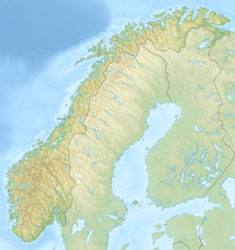Fosen Vind
| Fosen Vind | |
|---|---|
|
Location of Fosen Vind on the Fosen peninsula, Norway
|
|
| Country | Norway |
| Location | Fosen peninsula, Trøndelag |
| Coordinates | 63°43′N 10°15′E / 63.717°N 10.250°ECoordinates: 63°43′N 10°15′E / 63.717°N 10.250°E |
| Status | Under construction |
| Construction began | August 2016 |
| Construction cost | 1.1 billion € |
| Owner(s) | Statkraft (52.1%), TrønderEnergi (7.9%), Nordic Wind Power DA (40.0%) |
| Wind farm | |
| Type | Onshore |
| Hub height | 87 m |
| Rotor diameter | 117 m, 112 m |
| Power generation | |
| Units operational | 278 (under construction) |
| Make and model | Vestas V117-3.6 MW (248), V112-3.6 MW (30) |
| Nameplate capacity | 1,000 MW |
| Capacity factor | 39% (projected) |
Fosen Vind is a group of six onshore wind farms under construction in Fosen, Norway, scheduled for a gradual commissioning in 2018-20. With a nameplate capacity of 1 GW the project will become Europe's largest onshore wind farm and more than double Norway's capacity for wind power generation.
The site has been chosen for its wind pattern with annual yields of more than 3,600 full load hours close to 9 m/s, similar to offshore sites.
The group of six wind farms will comprise 278 wind turbines from Vestas, 248 V117 and 30 V112, each with its capacity optimized from 3.45 MW to 3.6 MW, for a total capacity of 1,000 MW. Each turbine has a nacelle height of 87 m and a wing span of either 117 m or 112 m.
The transmission lines will use transmission towers of composite materials with foundations that do not require the use of explosives, reducing the environmental impact of the construction work.
The expected cost of the project is 1.1 billion €. The investors are Statkraft (52.1%), TrønderEnergi (7.9%) and a consortium Nordic Wind Power DA (40.0%) backed by Credit Suisse.
The levelised cost of energy (LCoE) is estimated in the range 35 €/MWh to 40 €/MWh, which is below a typical Norwegian wind farm price of 44 €/MWh and described as a rock-bottom price obtained via economies of scale.
The project will receive government subsidies in the form of tradeable green certificates, which are typically valued at 15 €/MWh. Together with a current system price around 18 €/MWh to 20 €/MWh, the operator will likely receive the lower estimate of the LCoE.
Of the expected annual production of 3.4 TWh (corresponding to 3,400 full load hours), about one third will actually be sold to Norsk Hydro as baseload supply for their aluminium production under a power purchase agreement. Specifically, the agreement stipulates delivery of around 0.6 TWh in 2020, around 1.0 TWh annually from 2021-2035 and 0.7 TWh annually from 2036-2039, for a total of about 18 TWh over a 20-year period.
...
Wikipedia

